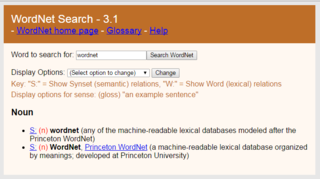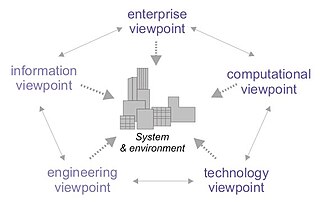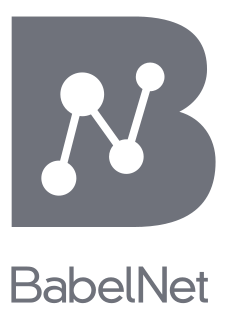
WordNet is a lexical database of semantic relations between words in more than 200 languages. WordNet links words into semantic relations including synonyms, hyponyms, and meronyms. The synonyms are grouped into synsets with short definitions and usage examples. WordNet can thus be seen as a combination and extension of a dictionary and thesaurus. While it is accessible to human users via a web browser, its primary use is in automatic text analysis and artificial intelligence applications. WordNet was first created in the English language and the English WordNet database and software tools have been released under a BSD style license and are freely available for download from that WordNet website.
The XML Metadata Interchange (XMI) is an Object Management Group (OMG) standard for exchanging metadata information via Extensible Markup Language (XML).

A semantic lexicon is a digital dictionary of words labeled with semantic classes so associations can be drawn between words that have not previously been encountered. Semantic lexicons are built upon semantic networks, which represent the semantic relations between words. The difference between a semantic lexicon and a semantic network is that a semantic lexicon has definitions for each word, or a "gloss".

Reference Model of Open Distributed Processing (RM-ODP) is a reference model in computer science, which provides a co-ordinating framework for the standardization of open distributed processing (ODP). It supports distribution, interworking, platform and technology independence, and portability, together with an enterprise architecture framework for the specification of ODP systems.
Linguistic categories include
Computational lexicology is a branch of computational linguistics, which is concerned with the use of computers in the study of lexicon. It has been more narrowly described by some scholars as the use of computers in the study of machine-readable dictionaries. It is distinguished from computational lexicography, which more properly would be the use of computers in the construction of dictionaries, though some researchers have used computational lexicography as synonymous.

ISO/TC 37 is a technical committee within the International Organization for Standardization (ISO) that prepares standards and other documents concerning methodology and principles for terminology and language resources.
Machine-readable dictionary (MRD) is a dictionary stored as machine (computer) data instead of being printed on paper. It is an electronic dictionary and lexical database.
In digital lexicography, natural language processing, and digital humanities, a lexical resource is a language resource consisting of data regarding the lexemes of the lexicon of one or more languages e.g., in the form of a database.
A multilingual notation is a representation in a lexical resource that allows the translation between two or more words.
The Ubiquitous Knowledge Processing Lab is a research lab at the Department of Computer Science at the Technische Universität Darmstadt. It was founded in 2006 by Iryna Gurevych.
SemEval is an ongoing series of evaluations of computational semantic analysis systems; it evolved from the Senseval word sense evaluation series. The evaluations are intended to explore the nature of meaning in language. While meaning is intuitive to humans, transferring those intuitions to computational analysis has proved elusive.

BabelNet is a multilingual lexicalized semantic network and ontology developed at the NLP group of the Sapienza University of Rome. BabelNet was automatically created by linking Wikipedia to the most popular computational lexicon of the English language, WordNet. The integration is done using an automatic mapping and by filling in lexical gaps in resource-poor languages by using statistical machine translation. The result is an encyclopedic dictionary that provides concepts and named entities lexicalized in many languages and connected with large amounts of semantic relations. Additional lexicalizations and definitions are added by linking to free-license wordnets, OmegaWiki, the English Wiktionary, Wikidata, FrameNet, VerbNet and others. Similarly to WordNet, BabelNet groups words in different languages into sets of synonyms, called Babel synsets. For each Babel synset, BabelNet provides short definitions in many languages harvested from both WordNet and Wikipedia.
UBY-LMF is a format for standardizing lexical resources for Natural Language Processing (NLP). UBY-LMF conforms to the ISO standard for lexicons: LMF, designed within the ISO-TC37, and constitutes a so-called serialization of this abstract standard. In accordance with the LMF, all attributes and other linguistic terms introduced in UBY-LMF refer to standardized descriptions of their meaning in ISOCat.
UBY is a large-scale lexical-semantic resource for natural language processing (NLP) developed at the Ubiquitous Knowledge Processing Lab (UKP) in the department of Computer Science of the Technische Universität Darmstadt . UBY is based on the ISO standard Lexical Markup Framework (LMF) and combines information from several expert-constructed and collaboratively constructed resources for English and German.
In natural language processing, linguistics, and neighboring fields, Linguistic Linked Open Data (LLOD) describes a method and an interdisciplinary community concerned with creating, sharing, and (re-)using language resources in accordance with Linked Data principles. The Linguistic Linked Open Data Cloud was conceived and is being maintained by the Open Linguistics Working Group (OWLG) of the Open Knowledge Foundation, but has been a point of focal activity for several W3C community groups, research projects, and infrastructure efforts since then.

Joseph Mariani is a French computer science researcher and pioneer in the field of speech processing.
Helen Aristar-Dry is an American linguist who currently serves as the series editor for SpringerBriefs in Linguistics. Most notably, from 1991 to 2013 she co-directed The LINGUIST List with Anthony Aristar. She has served as principal investigator or co-Principal Investigator on over $5,000,000 worth of research grants from the National Science Foundation and the National Endowment for the Humanities. She retired as Professor of English Language and Literature from Eastern Michigan University in 2013.
OntoLex is the short name of a vocabulary for lexical resources in the web of data (OntoLex-Lemon) and the short name of the W3C community group that created it.
In linguistics and language technology, a language resource is a "[composition] of linguistic material used in the construction, improvement and/or evaluation of language processing applications, (...) in language and language-mediated research studies and applications."




